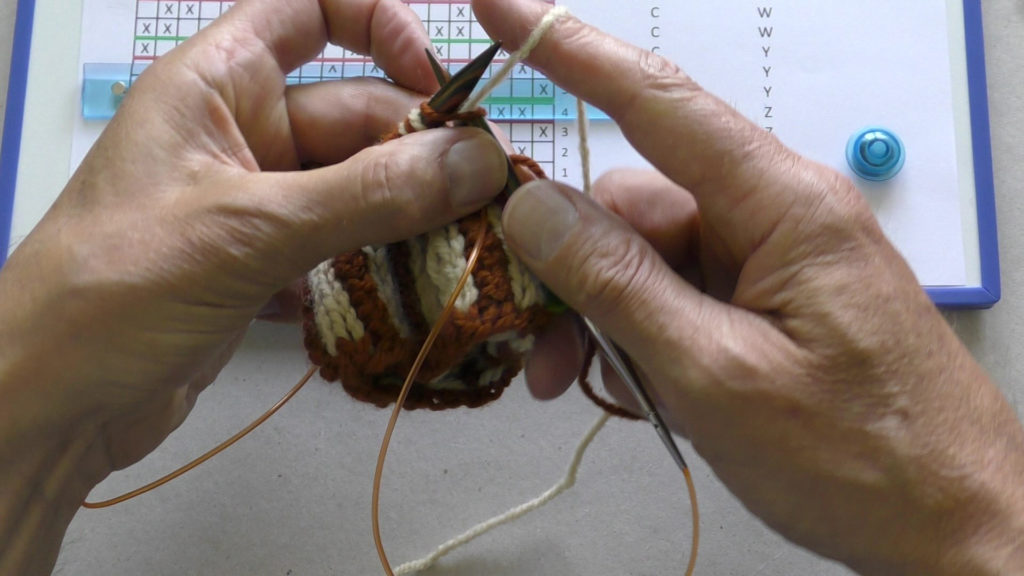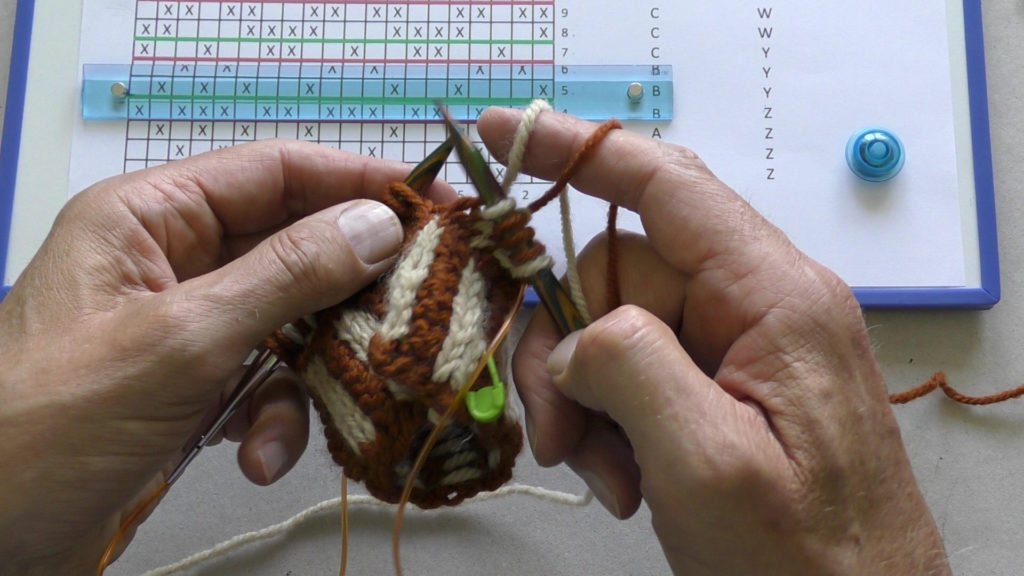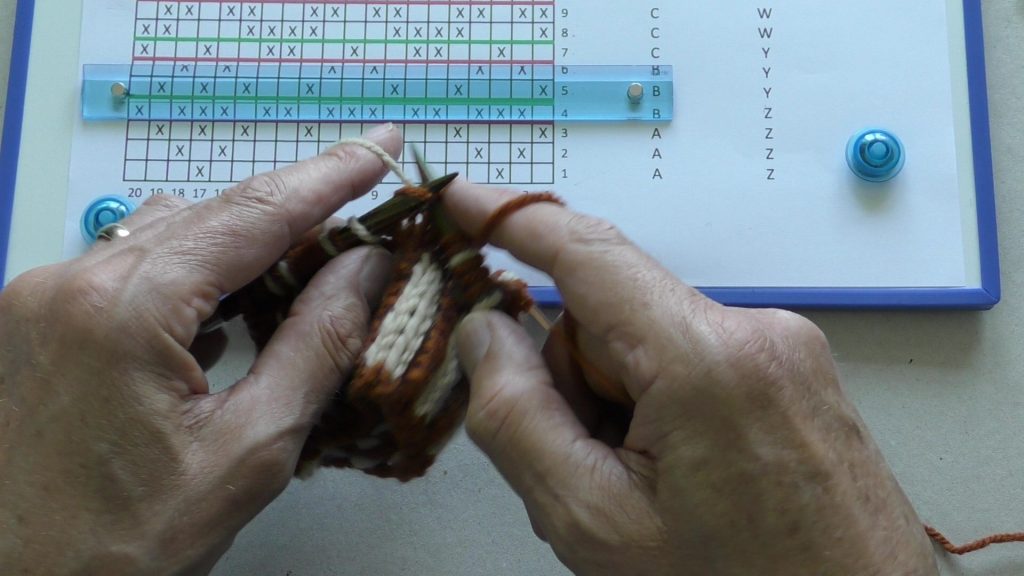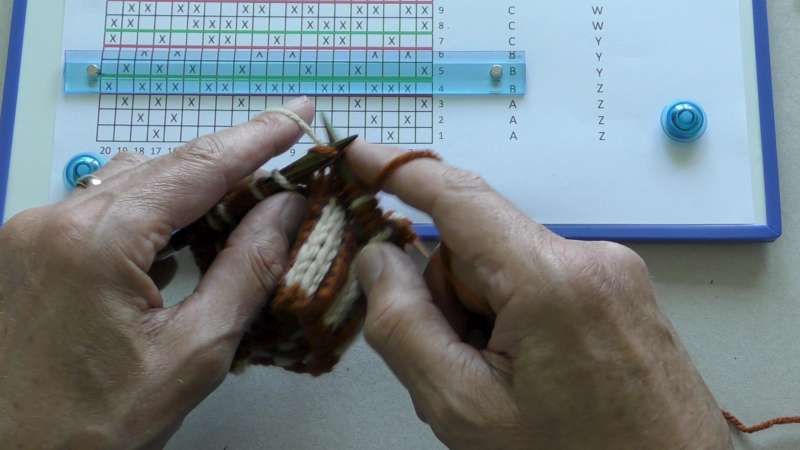Updated August 2020.
This T-torial suggests several ways of holding the yarn when using two colours for stranded knitting.
The transcript of the video is in the section “Transcript“
Common choices for holding yarn for stranded colourwork
Options

Use one yarn at a time
Pick up and drop each yarn as you use it. Use your preferred hand and knitting style.

Both in same hand
Hold both yarns in the same hand and work with the one that is needed. Use your preferred hand and knitting style. You can hold the strands on the same finger, or on different fingers.

One yarn in each hand
Hold one yarn in each hand. Work the yarn in your left hand in continental style, and the yarn in your right hand English style.
Managing colour dominance
Colour dominance refers to the situation when one colour in stranded colour work stands out relative to the other(s), not because of the intensity of the colour itself, but because the stitches in that colour are larger than those in the other colour(s).
When you are working with two colours and work stitches conventionally from the left to the right needle, the yarn that is held to the left (or furthest from the needle) approaches the needle from below the yarn held on the right. This means that the knit loop is slightly longer than the loop for the stitch knit with the other yarn.
Colour dominance is most noticeable if the yarns are not held in the same order throughout the project. If you hold the contrast colour to the left for part of the project, and to the right for another part, it is likely that this will show up as a distinct change in the appearance of the motifs.
You can reduce the impact of colour dominance by adapting your knitting style.
- Keep the yarns in the same order (e.g. contrast colour always the left-most). When working flat (backwards and forwards), change the order of the yarns as you turn the fabric (because the right hand yarn creates longer loops when purling).
- Keep floats loose by spreading stitches on right hand needle when catching floats or changing colour.
- Work stitches on the shaft, not the tip, of the needle.
These practices will ensure that the colour dominance does not change as you work through your project.
If you find that, even taking these precautions, one colour dominates the other, a more complete solution is to twist the yarns around each other at each colour change to force the working yarn to emerge from below the other yarn. You need to alternate the direction of the twist if you want to avoid having to untangle the yarns every so often. Twisting the yarns is also likely to make you work more slowly.
It may not be colour dominance
In this t-torial, “colour dominance” has referred to the impact of how the stitches are formed on how the colours appear. There is at least one other reason that one colour may be more prominent than others that has nothing to do with how you work.
Different dyes have more impact on the yarn than just changing its colour. Some dye-yarn combinations result in yarns that are more lofty than others, with a bigger diameter. A bigger diameter is going to result in a more prominent stitch (even if the height and width of the stitch are the same as those surrounding it, the centre is going to be less open).
Transcript of video
Titles
Hello. I’m Steve, also known as Teabreak Knitter on social media. In this T-torial I’m going to show you how I hold the yarn when I am doing stranded knitting.
I’m going to show you three methods. The first is where you knit with one yarn, then put it down, lift the other yarn, knit with that, then put that down, and keep changing your yarns as you proceed through your knitting. The second method I am going to show you is where you hold one yarn in your right hand, and the other yarn in your left hand. With the yarn on your right you use the English method of knitting, and with the yarn on your left you use the continental style. The third method I am going to show you is where you hold both yarns in the same hand and you choose which yarn you knit with depending on which stitch you’re going to do.
Let’s look at how I do that in more detail.
Pick up yarn, knit. Pick up other yarn, knit.
The first method of holding yarn that I want to show you is where you pick up one yarn, knit with it, put that one down and pick up the next one and knit with that, and keep repeating it as you need to in the pattern.
I have here a swatch that has a simple pattern of two stitches in one colour, two stitches in the next colour. I am going to start off with the light colour.
I am going to show you the English method, so I pick up that yarn and knit two stitches with it. (So that’s knit two stitches) I then put down the yarn. I pick up the other yarn. [So you can see what I’m doing] I’ll keep this yarn out of the way, so I will just hold it there with my other hand. And knit two stitches with it.
So that is holding the yarn, picking it up and dropping it using the English method of knitting.
I will do that continental style.
Pick it up. This time I’m holding the yarn in my left hand. I knit two stitches, then I’m going to switch yarns. [To help you see what is happening] If I pull the other one across, you can see here that it is crossing over the top of the light coloured yarn. Then I am going to put that down. I am always keeping the dark coloured yarn on my right and the light coloured yarn on the left.
That is four stitches knit English, and four continental.
Hold one yarn in each hand
The method I want to show you now is where you hold one yarn in each hand.
Hold the yarn [the yarn on the right] as you would normally do for English knitting, and [the one on the left] as you would normally hold it for continental knitting.
The first two stitches are in the light colour, which is held in my left hand. The motif colour. And I knit those two continental [style].
And I knit the next two [dark colour] stitches English [style].
Again, [knit two] continental, [knit two] English.
Once you have learnt to use knit with either hand, this is very easy to do because you’re not constantly picking up and putting down your yarns. It also means that it is easier to hold the yarns and keep them in the same relative position.
Hold both yarns in the same hand.
The last way I want to show you is to knit with both yarns held in one hand.
I’ll start off doing that with the English method.
I will lay the two yarns out there. This time the yarn will be held in my right hand. Tension them. Put them over the finger. I want to keep the light coloured yarn always closer to the tip of my finger than the dark coloured yarn.
I start off knitting with the light colour yarn. What you can see there is that the dark coloured yarn is actually keeping above the light coloured yarn. And the second one.
You can see as I am knitting, with all the styles of knitting, I am keeping the stitches back on the barrel of the needle, not on the pointed tips, but on the barrel, and I am spreading them out. The reason I am spreading them out is so that those floats across the back here aren’t pulling the stitches tight.
Now, as I change to using the dark coloured yarn, I am still knitting English.
I’ll catch the dark yarn and pull it round. Although it appears to be going underneath the light yarn, that is only because of the angle that I am holding it for the camera. When I knit with the light [yarn] it will actually come out when I come out from on top.
Again, knitting keeping the same position for the light [yarn], and now I’ll change the other way round.
I’ll just show you that Continental. Keep the two yarns in the same order, so that the light coloured yarn is on my left.
You knit with the light coloured yarn making sure it comes out from underneath the dark colour yarn. And then the dark coloured yarn, making sure it comes out on top of the light colored yarn.
And that is one row, knit using three different techniques: pickup and drop, either English or continental; one each hand, using both English and continental; or both in the same hand, either English or continental.
That’s great if you are knitting in the round, because you are only doing knit stitches.
Working on the purl side. Pick up yarn, purl. Pick up other yarn, purl.
What happens if you’re up purling? Or knitting flat, when you have to purl?
I’ll turn it [the swatch] round and I’ll do the same thing again. Again, I’m keeping the yarns off to the side [with one on each side]. This time the yarns have got to be in front, because I am purling. Insert the needle as usual.
This time, of course, the start of the row is going to be the dark colour.
You can see here that I have let the light coloured yarn wrap around the end, which makes it easier for the next [light] stitches, because the yarn is coming from the right direction.
That is my two stitches purled in the dark colour.
I now lift up the light yarn, it is coming up from underneath the dark yarn again. And purl two stitches.
Now I am back to the dark coloured yarn. This time I’m going to do it continental style.
Knit continental: 1, 2. I am holding the yarn in front when knitting continental because this is a purl row, rather than holding the yarn behind and doing the purl stitch from behind.
And the two light coloured yarns.
So, there we are:
Pick up and drop [when] purling, using the English and using the continental method.
Again, keeping those floats nice and loose.
Hold one yarn in each hand and purl.
This time, again I’m going to show you doing it with one yarn in each hand. So, again, English and continental. The dark ones [stitches] are [purled] English, the light ones [are purled] Continental. The dark ones are English, the light ones continental. You can see that you are not breaking your rhythm by constantly having to pick up and put down the yarn.
Hold both yarns in one hand and purl
Now the third way of doing it. I am going to hold both yarns in the same hand. You will probably find that it is more difficult for you to see because my hands will get the way. Bring the dark yarn over and purl with it. I am holding it in a strange way so that you can see what I am doing. The dark yarn is coming from on top – I’ll put those yarns back on my finger – and now with the light coloured yarn just catch the correct yarn as you are purling with it. Doing that again continental style, pick up the yarns. Make sure that the dark yarn is to the right, because it’s going to come from the top. Purl that stitch, purl the next stitch. And then the next one is going to come from the light coloured yarn which, because it is held to the left, will come from underneath the other one. Like that. So that is the purl side: picking and dropping English, picking and dropping Continental; held in both hands with yarn in one hand English and continental.
Starting the row on the knit side
Knitting flat, when you reach the end of the row, one of the yarns hasn’t reached the end of the row. It is a stitch or two in. and if, as you are in this pattern, you then continue to knit you will tend to pull those end stitches apart. One way round that is to trap that yarn as you start the row.
I am going to be showing you with one yarn in each hand, because that’s how I normally knit my colour work. What I have done there is that I have pulled that yarn forward when I was knitting, So it is now caught behind that second stitch. So now when I knit, the yarn is coming from the right hand side, as it would normally.
Starting the row on the purl side
Here we are, ready to start working on the purl side and this time it is the light yarn that has not reached the end. So, I will pick up the yarns and needle. This time I just place that light yarn over the needle, wrap the yarn and bring it forward. That yarn is now trapped by this end yarn, so that as I start to knit, the yarn now comes from the right, so that it doesn’t pull the stitches apart.
Summary
You have seen how I hold my yarns when I do stranded knitting. I hope you found it useful. Until the next time, Happy Knitting!



